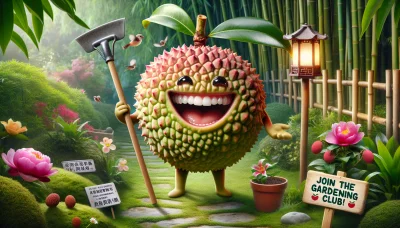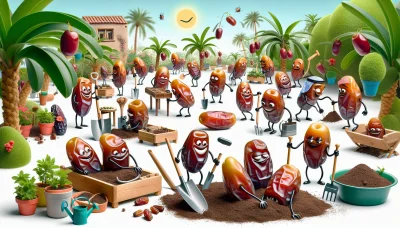Asian guava Quiz
Test Your Knowledge
Question of
Introduction to Asian Guava
Asian guava, also known as Psidium guajava, is a tropical fruit native to Mexico, Central America, the Caribbean, and northern South America. This fruit has been widely spread throughout the tropics and subtropics of the world, becoming a major species in the Asian fruit market. Characterized by its green to yellow skin, the fruit encases sweet, pink or white flesh with edible seeds. Asian guavas are rich in dietary fiber, vitamins C and A, and contain several other essential nutrients, making them not only a delicious treat but also a beneficial addition to a healthy diet. Their adaptability to different environments and the relatively easy cultivation process have contributed to their popularity and widespread availability.
Benefits of Growing Asian Guava
Asian guava, a tropical fruit rich in nutrients, offers a vast array of health benefits that make it a valuable addition to any garden. Packed with vitamins A and C, it surpasses many citrus fruits in its vitamin content, providing a significant boost to the immune system. Its high fiber content aids in digestion and can help in weight management efforts. The presence of antioxidants in Asian guava contributes to its ability to fight free radicals, reducing the risk of chronic diseases. Moreover, its adaptability to various soil types and climates, along with its drought resistance, makes it an excellent choice for gardeners seeking both nutritional benefits and ease of cultivation. Adding Asian guava to your garden not only enhances your diet with a delicious and nutritious fruit but also contributes to a healthier, more sustainable lifestyle.
How to Plant and Care for Asian Guava
- Choosing the Right Spot: Select a location that receives full sunlight for most of the day. Asian guava thrives in warm, sunny environments.
- Soil Requirements: Ensure the soil is well-draining with a pH between 5.5 and 7. If the soil is too dense, amend it with compost or peat moss to improve drainage.
- Planting: Dig a hole twice as wide and the same depth as the root ball. Place the guava tree in the hole and backfill with soil, gently tamping down to remove air pockets.
- Watering: Water the guava tree deeply at planting. Continue to water deeply once a week, allowing the soil to dry out slightly between waterings. Adjust watering based on rainfall and temperature.
- Sunlight Needs: Asian guava requires full sun to produce fruit. Ensure it gets at least 6 to 8 hours of direct sunlight daily.
- Mulching: Apply a 2 to 3-inch layer of organic mulch around the base of the tree to retain soil moisture and regulate soil temperature.
- Fertilizing: Feed the guava tree with a balanced fertilizer every 1-2 months during the growing season. Follow the manufacturer's instructions for the best results.
- Pruning: Prune in late winter or early spring to remove dead or crossing branches and to shape the tree. This promotes healthy growth and fruit production.
Common Pests and Diseases Affecting Asian Guava
Gardeners growing Asian guava often encounter several pests and diseases that can significantly impact the health and productivity of their plants. Among the most common pests are fruit flies, which lay their eggs inside the guavas, and guava moth larvae, which burrow into the fruit, causing it to rot. To combat these pests, gardeners can use fruit fly traps and ensure regular harvesting to prevent the fruit from over-ripening and attracting pests. Diseases such as anthracnose, a fungal infection that causes dark, sunken lesions on fruits, and guava wilt disease, caused by a fungus that leads to wilting and death of the plant, are also prevalent. Effective management includes pruning and destroying infected plant parts, applying fungicides, and ensuring good drainage to prevent the conditions that favor these diseases. Regular monitoring and adopting integrated pest and disease management strategies can help keep these issues at bay and ensure a healthy guava crop.
Harvesting and Using Asian Guava
Knowing when Asian guavas are ripe for harvesting is key to enjoying their full flavor. Typically, guavas are ready to be picked when they give off a fragrant aroma and yield slightly to gentle pressure. The skin color may also change, depending on the variety, from green to yellow or light green. Once harvested, Asian guavas can be a delightful addition to various recipes or consumed fresh. They are excellent in jams, jellies, and marmalades due to their high pectin content. For a refreshing treat, try blending them into smoothies or juices. Guavas can also be sliced and added to salads for a tropical twist or used in baking for unique desserts. Their rich flavor and nutritional benefits make them a versatile fruit in both sweet and savory dishes.
Pruning and Maintenance Tips for Asian Guava
- Timing: The best time to prune Asian guava trees is in the late winter or early spring before the new growth begins.
- Sanitation: Always use clean, sharp pruning tools to prevent the spread of disease. Disinfect your tools before and after use with a solution of 1 part bleach to 9 parts water.
- Thinning: Remove any dead, diseased, or damaged branches to help improve air circulation and light penetration throughout the canopy. This also helps in reducing the chances of fungal and bacterial diseases.
- Shaping: Shape the tree to allow for easy harvesting and to encourage growth. A well-shaped tree should have a single trunk with 3 to 5 main branches forming a wide-angle with the trunk.
- Height Control: Keep the tree at a manageable height, ideally not taller than you can reach. This makes it easier to harvest the fruit and perform maintenance tasks.
- Watering: Water your guava tree deeply but infrequently to encourage deep root growth. The frequency will depend on your climate, but ensuring the soil is moist (not waterlogged or dry) is key.
- Fertilizing: Apply a balanced fertilizer every 1-2 months during the growing season to support healthy growth and fruit production. Ensure the fertilizer is applied at the drip line and not against the trunk to avoid burn.
- Mulching: Apply a layer of organic mulch around the base of the tree to help retain soil moisture, regulate soil temperature, and reduce weed competition. Keep the mulch a few inches away from the trunk to prevent rot.
- Pest and Disease Control: Regularly inspect your tree for signs of pests and diseases. Treat infestations or infections early to prevent them from spreading. Use organic pesticides and fungicides whenever possible to minimize harm to beneficial insects.
- Harvesting: Harvest the fruits when they are fully ripe for the best flavor. Guava can ripen off the tree, so slightly underripe fruits can be picked and allowed to ripen indoors if necessary.
FAQs About Growing Asian Guava
| Question | Answer |
|---|---|
| What climate is best for growing Asian guava? | Asian guava thrives in tropical and subtropical climates but can also tolerate mild temperate climates. It prefers temperatures between 68°F and 82°F (20°C - 28°C). |
| How much water does an Asian guava tree need? | Young trees need regular, deep watering to establish roots. Mature trees require less frequent watering but appreciate a good soak during dry periods. Over-watering can lead to root rot. |
| What type of soil is suitable for Asian guava? | Asian guava does well in a wide range of soils but prefers well-draining soil with a pH between 5.5 and 7.0. It's tolerant of both light and heavy soils. |
| How often should I fertilize my Asian guava tree? | Fertilize young trees every 1-2 months with a balanced fertilizer. Reduce to 3-4 times a year for mature trees. Avoid high nitrogen fertilizers as they can reduce fruiting. |
| When is the best time to prune an Asian guava tree? | Prune in late winter or early spring to remove dead or diseased wood and to shape the tree. Light pruning can be done throughout the year to remove water shoots and suckers. |
| How long does it take for an Asian guava tree to bear fruit? | Asian guava trees can bear fruit as early as 2 years after planting, but it may take up to 4 years for some varieties to produce fruit. |
| What pests and diseases commonly affect Asian guava trees? | Asian guava trees can be affected by pests like fruit flies, guava moth, and aphids. Common diseases include anthracnose, root rot, and guava wilt disease. |
| Can Asian guava be grown in pots? | Yes, Asian guava can be grown in large pots with proper drainage. This is especially useful in regions with cold winters, as the tree can be moved indoors to protect it from frost. |
| How do I harvest Asian guava? | Harvest when the fruit lightens in color and emits a strong, sweet fragrance. Use a sharp knife or scissors to cut the fruit from the branch, leaving a small piece of stem attached. |
| Can Asian guava trees be grown from seeds? | Yes, but trees grown from seeds may take longer to fruit, and the fruit quality may not be as good as that of trees grown from cuttings or grafts. |












